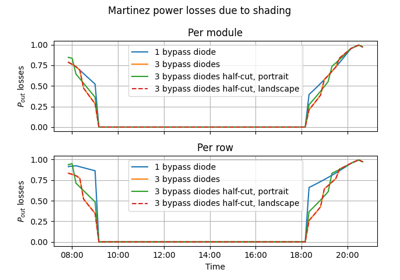pvlib.shading.direct_martinez#
- pvlib.shading.direct_martinez(poa_global, poa_direct, shaded_fraction, shaded_blocks, total_blocks)[source]#
A shading loss power factor for non-monolithic silicon modules and arrays with an arbitrary number of bypass diodes.
This experimental model reduces the direct and circumsolar irradiance reaching the module’s cells based on the number of blocks affected by the shadow. More on blocks in the Notes section and in [1].
Added in version 0.11.0.
- Parameters:
poa_global (numeric) – Plane of array global irradiance. [W/m²].
poa_direct (numeric) – Plane of array direct and circumsolar irradiance. [W/m²].
shaded_fraction (numeric) – Fraction of module surface area that is shaded. [Unitless].
shaded_blocks (numeric) – Number of blocks affected by the shadow. [Unitless]. If a floating point number is provided, it will be rounded up.
total_blocks (int) – Number of total blocks. Unitless.
- Returns:
shading_losses (numeric) – Fraction of DC power lost due to shading. [Unitless]
Notes
The implemented equations are (6) and (8) from [1]:
\[ \begin{align}\begin{aligned}(1 - F_{ES}) = (1 - F_{GS}) \left(1 - \frac{N_{SB}}{N_{TB} + 1}\right) \quad \text{(6)}\\\left(1 - \frac{P_{S}}{P_{NS}}\right) = \left(1 - \frac{\left[(B + D^{CIR})(1 - F_{ES}) + D^{ISO} + R\right]}{G}\right) \quad \text{(8)}\end{aligned}\end{align} \]In (6), \((1 - F_{ES})\) is the correction factor to be multiplied by the direct and circumsolar irradiance, \(F_{GS}\) is the shaded fraction of the collector, \(N_{SB}\) is the number of shaded blocks and \(N_{TB}\) is the number of total blocks.
In (8), \(\frac{P_{S}}{P_{NS}}\) is the fraction of DC power lost due to shading, \(P_{S}\) is the power output of the shaded module, \(P_{NS}\) is the power output of the non-shaded module, \(B + D^{CIR}\) is the beam and circumsolar irradiance, \(D^{ISO} + R\) is the sum of diffuse and albedo irradiances and \(G\) is the global irradiance.
Blocks terminology:
A block is defined in [1] as a group of solar cells protected by a bypass diode. Also, a block is shaded when at least one of its cells is partially shaded.
The total number of blocks and their layout depend on the module(s) used. Many manufacturers don’t specify this information explicitly. However, these values can be inferred from:
the number of bypass diodes
where and how many junction boxes are present on the back of the module
whether or not the module is comprised of half-cut cells
The latter two are heavily correlated.
For example:
A module with 1 bypass diode behaves as 1 block.
A module with 3 bypass diodes and 1 junction box is likely to have 3 blocks.
A half-cut module with 3 junction boxes (split junction boxes) is likely to have 3x2 blocks. The number of blocks along the longest side of the module is 2 and along the shortest side is 3.
A module without bypass diodes doesn’t constitute a block, but may be part of one.
Examples
Minimal example. For a complete example, see Modelling shading losses in modules with bypass diodes.
>>> import numpy as np >>> from pvlib import shading >>> total_blocks = 3 # blocks along the vertical of the module >>> POA_direct_and_circumsolar, POA_diffuse = 600, 80 # W/m² >>> POA_global = POA_direct_and_circumsolar + POA_diffuse >>> P_out_unshaded = 3000 # W >>> # calculation of the shaded fraction for the collector >>> shaded_fraction = shading.shaded_fraction1d( >>> solar_zenith=80, solar_azimuth=180, >>> axis_azimuth=90, shaded_row_rotation=25, >>> collector_width=0.5, pitch=1, surface_to_axis_offset=0, >>> cross_axis_slope=5.711, shading_row_rotation=50) >>> # calculation of the number of shaded blocks >>> shaded_blocks = np.ceil(total_blocks*shaded_fraction) >>> # apply the Martinez power losses to the calculated shading >>> loss_fraction = shading.direct_martinez( >>> POA_global, POA_direct_and_circumsolar, >>> shaded_fraction, shaded_blocks, total_blocks) >>> P_out_corrected = P_out_unshaded * (1 - loss_fraction)
See also
shaded_fraction1dto calculate 1-dimensional shaded fraction
References
Examples using pvlib.shading.direct_martinez#

Modelling shading losses in modules with bypass diodes
